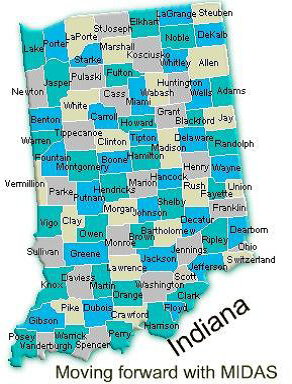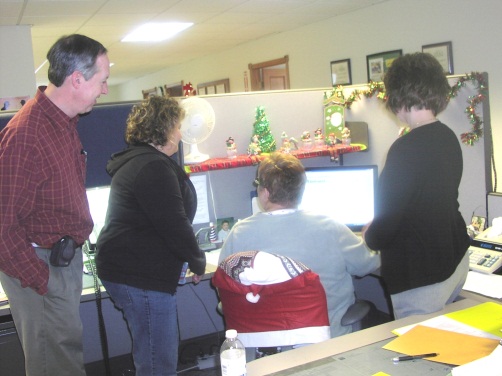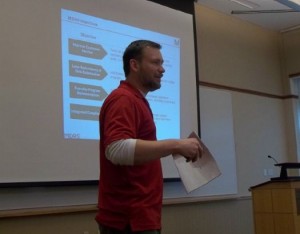The Challenge of Change

- Carolyn B. Cooksie Executive Sponsor for MIDAS Associate Administrator for Operations and Management Farm Service Agency Ms. Cooksie’s Advice for MIDAS • In today’s world, if you’re afraid of change, you will miss out on opportunities for the agency, for customers and for yourself personally • Be open minded • Embrace change • If you see something you don’t like, don’t be sullen and silent or just complain. Instead, be open and honest and provide constructive criticism; share your ideas about changes you’d like to see.
By: Carolyn Cooksie
My name is Carolyn B. Cooksie and I’ve been with USDA for over 35 years. Looking back at the milestones over the last three decades, I am especially proud of one of my latest jobs: serving as the Executive Sponsor for MIDAS.
MIDAS enables a transformational change for FSA, one that is long overdue. When I look down the road at the budget pressures we face, I believe that MIDAS is pivotal to getting us through. As an agency, we have to get streamlined. While our staff here in D.C. and throughout the country has toiled for years to provide best-of-the-best customer service to our farmers and ranchers, they have had to do back bends to work around ancient systems. While state and county offices cannot wait for MIDAS to get here, any big change like this poses equally big challenges.
When I think about the MIDAS implementation, I am reminded of a similar transformation I led in 2004 for Farm Loans. The Farm Business Plan initiative was a Commercial Off-The-Shelf (COTS) software implementation to replace an old electronic paper-based system. I’d like to say that the old system was held together with bailing twine and duct tape! Although handicapped with this system, our staff kept it going so they could serve our farmers. But enough was enough: it was time for a big change.
At first, only a handful of champions really wanted the new system, and they stepped up as leaders to bring about change throughout the implementation; however, as soon as we started showing nuggets of progress, the real grumbling began. People began to realize that the Farm Business Plan was for real and they would have to learn the new software and let go of their old ways. This was natural — no matter how you cut it, it is hard for people to change.
Going through a change like this is almost like going through the stages of grief. There is denial, anger, eventually acceptance, and finally an invigorated new reality. People are going to move through these stages at different points in time. They’ll experience the emotions differently and in a more heightened way in one stage than another. So when I notice when I’m feeling a little off, I ask myself, what stage am I in? Going through a big change presents an opportunity for self-awareness for how we as individuals are feeling along the way. With that awareness, we can then choose how to act on our emotions and harness that energy to move our agency forward.
Rather than fight the Farm Business Plan resisters tooth and nail, my team and I took the time to acknowledge their perspectives and address what was challenging them. We brought in a university professor who talked about why change is so hard and how some people never will make the switch (just think about your friends who resisted getting a cell phone for years). After that, the strongest resisters were too embarrassed to show that they were ‘late majority adopters’ or ‘laggards,’ and they jumped into the training.
In the end, that professor’s wisdom prevailed. When the new system was turned on, a few staff members left or retired. Looking back, I see that as the natural fallout from a big transformation, and I think that’s a good thing. Not all changes are for everyone and you have to be honest with yourself as well as the agency and say when it is time to go.
Unfortunately, there’s no such thing as a perfect implementation. There were problems when we turned the Farm Business Plan system on, and at key points leading up to go-live. I don’t care how good it is, there will be a period when a big initiative hits some bumps in the road. For the Farm Business Plan, we worked through the bugs, made adjustments and got everything to sing. After all of these years, I am proud of how much better the Farm Business Plan has allowed Farm Loans to serve our customers and how much easier it is for our staff to do so.
When I look back, I find it funny that some of the loudest complainers changed their stories when the Farm Business Plan was a success — and they even took credit for it. I just have to laugh! I also noticed how some of the early champions and heavy lifters have climbed in their careers as a result of it because they were willing to step out of their comfort zones and embrace change.
I’m relating this story because I expect it will be the same for MIDAS. There will be naysayers every step of the way. When MIDAS is alive and well, they will say, “We were a part of it!”
As silly as it seems to think about Farm Loans still using the old Farm and Home Plan system in 2004, I am confident that we will someday look back on MIDAS and wonder how on earth we got by with multiple, silo-ed systems for so long. As our state and county office employees keep saying, “MIDAS can’t come soon enough!” In order for that change to happen, we have to remember it’s not just a technology change, it’s a mindset change.
MIDAS is just the start of innovation that FSA must take on if we’re going to survive as an agency. I’m eager for it to come now, but I also know as an USDA veteran that changes like this take time and have their challenges. When I see and feel the inevitable bumps in the road, I know they are really just signs that we’re making progress. I hope all of us in FSA and USDA step into this moment of transformation and do our part in making sure that MIDAS is designed and adopted for years to come. Someday soon, we will look back and think, “Look what I was a part of!” How many people get to come to work and make such a difference? I’m grateful that I get to be a part of it, and I am proud of every person who is helping to create MIDAS so we can ensure that FSA will provide premium service to our farmers for decades to come.
Carolyn Cooksie serves as the Associate Administrator for Operations and Management for FSA and is the Executive Sponsor for MIDAS.
Illinois Change Agent’s Perspective on MIDAS Progress

- Colleen Hill
By: Coleen Hill
Do you remember receiving the delivery notice for our New IBM System 36 CPU? That same kind of excitement is now traveling throughout Illinois in anticipation of the MIDAS project.
When asked by Illinois State Executive Director Sherrie Giamanco, to be a change agent for Illinois, my first thought was, “Wow, maybe now we can request a surveying tool for Arc GIS. A surveying tool would make recons so much easier to complete!” After watching the demo during a MIDAS conference call and seeing the SAP (Systems Applications and Products) capability, I am impressed by the commitment of the MIDAS team to listen to the various concerns and comments from stakeholders.
The MIDAS team has asked each change agent to collect feedback from staff and forward suggestions and/or concerns. Please take this opportunity to view the demos on the MIDAS Web page and provide feedback to your state change agents. If you have ever thought “I wish we could…” now is your opportunity.
MIDAS Demo Cross-Country Tour Paves the Direction Towards a Final Solution

- Laura Schlote
By: Laura Schlote
It was a tremendously rewarding summer on tour with the MIDAS demo crew. The tour began after months of working closely with state and county veterans, FSA business subject matter and technical experts. The end result was a collaborative demonstration to showcase SAP software functionality to the field offices.
The MIDAS team hit the road in May starting in Lancaster County, Pennsylvania. Throughout the rest of the summer, the MIDAS team visited counties in Missouri, New York, California, Washington, Wisconsin, Iowa, North Carolina and concluded at the National Association of FSA State and County Office Employees (NASCOE) convention in Texas. The mission was to provide a preview of the transformative business change MIDAS will bring to FSA and gather specific feedback to help develop the final MIDAS solution. The demo used realistic scenarios to illustrate how SAP can integrate multiple processes within a single system.
NASCOE attendees provided guidance for the next period of MIDAS’s evolution. Enthusiasm for the project was evident — more than 500 attendees granted spontaneous applause throughout the general assembly presentation and a continuous flow of people visited the demo stations throughout the two and a half days of the convention. It was even more encouraging that some people came back a second or a third time to see more. It was a thrill!
In total, 675 people viewed the demo, providing over 500 comments, which were overwhelmingly positive and enthusiastic. The collected feedback will help direct MIDAS’ evolution to best serve America’s farmers and ranchers in the coming decades. Specific praise was given around the integration of GIS maps into the application process and primary concerns surrounded ancillary issues. Across all demos there was a fundamental agreement that the system couldn’t come fast enough. While this is motivating, it is also daunting.
Creating a full, live system will be a complex process, requiring much more comprehensive detail.
A video recording of the demo is now available at www.fsa.usda.gov/midas.
MIDAS will be released iteratively, meaning that the release of the Initial Operating Capability (IOC) —targeted for the end of 2012 — will include only a subset of the planned MIDAS capabilities and future releases will incorporate new capabilities. This approach allows certain capabilities to be introduced to the field sooner and more efficiently. Our current challenge remains to identify the capabilities that we can feasibly build in time for next year’s release, and to plan logistics surrounding the features the staff need most.
MIDAS is managed by Farm Service Agency, Office of the Chief Information Officer
The MIDAS Leadership Team includes:
Executive Sponsor: Carolyn Cooksie, Associate Administrator for Operations and Management, FSA Modernization Executive: Jim Gwinn, Chief Information Officer, FSA Business Owner: Juan Garcia, Acting Deputy Administrator for Farm Programs, FSA Program Executive: Taylor Chasteen, Associate Chief Information Officer, USDA MIDAS Program Manager: Amy Allison, MIDAS Director, FSA
For information, please visit www. fsa.usda.gov/midas or contact the MIDAS office at (202)720-3833
 .
.
Adapting to Change…from Oklahoma to Life in the District!

- Nanette Pena
By: Nanette Pena
Greetings from D.C. It amazes me that over a year has flown by since I joined the MIDAS Project. I continue to marvel that my daily commute takes me by the National Mall and all of the monuments — it can be a bit surreal. In my pre-D.C. life, I was a program technician in Wagoner County, Okla., where tractors and combines are the only true traffic jams.
Traffic has not been the only adjustment. My son, Braden, began high school this year, and I’m sure anyone who has ever had teenagers can understand the adjustment I am talking about. On the project front, the demos wrapped up in August at the NASCOE Convention and the blueprinting phase of the MIDAS Project is now well underway. Blueprinting, as it sounds, lays out the specific “blueprint” of the FSA business, and the process is now approaching some major deadlines. The sessions attempt to answer the questions that will dictate what the system will look like. For example: What does the application process need to be able to do? What does Farm Records need to be able to do? Each process step is broken down to look at both improvements made and areas that can be streamlined along the way.
In between work and the adventures high school brings, it is now fall. We are having great football weather here in D.C., and my family and I are going to Fairfax High School games as well as catching fabulous Oklahoma State football whenever we can — Go Pokes
NASCOE Convention Garners Valuable Feedback
By: Gina Smith
The National Association of FSA State and County Office Employees (NASCOE) Convention was held from August 10–13 in Corpus Christi, Texas, during one of the region’s hottest and driest times. This being my first NASCOE Convention, it was delightful to experience Texas hospitality first hand.
The attending members of the MIDAS Team had the opportunity to provide a hands-on demonstration to conference attendees. This was very well received, producing great feedback from participants. Comments heard around the booth included, “This will save a lot of time and confusion,” “This will be more efficient,” “When can I use it in the office?” and many similar ideas.
Neither NASCOE nor MIDAS know exactly what the future holds, but the efforts of both are genuinely striving to find a better way of accomplishing the tasks at hand. An old saying goes something like this: “The fool says this is how it’s always been done, and the wise say there has to be a better way”.
I want to be a member of the “better way” camp. Now, with one national convention as a part of my experience, I look forward to the next, striving to find better ways to accomplish the tasks given to us as FSA employees.












